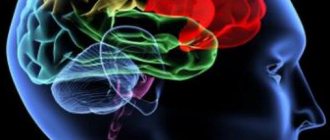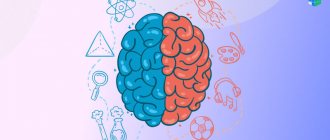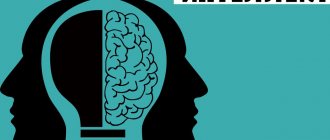Article:
Intelligence... With this word, many of us feel a kind of pride, since it is known that a person possesses it to the highest degree. Some even think that intelligence is something that only humans have. We will have to disappoint them: animals also have intelligence. Some even try to speculate about its presence in plants and other groups of organisms, but so far this has not gone beyond the bounds of science fiction. Recently, developments in the field of artificial intelligence have achieved great results.
What is intelligence
Intelligence is the mental ability of the body, expressed in the ability to solve various problems, cope with problems, carry out cognitive activity, adapt to changing environmental conditions and manage it.
Intelligence is manifested in educational, research, work activities, communication and social life in general. This concept unites individual cognitive abilities: sensations, perception, memory, ideas, thinking, imagination, will, reflection, attention.
The concept of intelligence arose relatively recently - only at the end of the nineteenth century. At that time, psychology was developing at a rapid pace, and researchers were studying the mental abilities of humans and animals. Sometimes they made serious mistakes. Thus, at that time, the prevailing belief was that a person uses only a few percent of his brain, while the rest of it remains unused. In everyday life, this idea still persists, but it is fundamentally incorrect and was refuted by science a long time ago. But how could such an assumption even arise? The fact is that at the end of the nineteenth century the functions of a significant part of the brain were not yet studied, and researchers could not understand what they were needed for. In addition, some processes in the brain occur as if in an automatic mode, without the participation of human consciousness. That is, it seems to us that some part of the brain is inactive, but in fact it carries out extremely important work unnoticed by us, without which, probably, intelligence itself would become impossible.
However, the issue of the relationship between intelligence and the brain is quite complex. Does man have intelligence? Of course there is. But does a cat have it? Probably there is too. What about the lizard? One might think that she has it too. What about an ant, a microbe, a plant? At first glance, it seems that the more developed the organism, the more we can talk about the presence of intelligence. But here, too, not everything is so simple.
Ants, like all other insects, do not have a brain at all. Their "brains", dispersed throughout the body, are a primitive nerve cluster. And the entire structure of the ant organism is very primitive. Meanwhile, some even seriously compare the intellectual abilities of ants with those of humans. Ants can accumulate and transmit information, communicate, learn, and they have a complex hierarchy. They can navigate the terrain; recent research shows that they apparently can even count. In ant society there are many “professions”, the variety of which varies for each species. In fact, the life of an anthill is very reminiscent of human society.
A lizard is an organism of a completely different kind. Its overall development is tens of times more complex and organized than that of an ant. And there is a full-fledged brain, and a fairly developed one at that. But the intellectual abilities of a lizard are very modest and cannot be compared with the intelligence of an ant (and even more so a human).
It turns out that intelligence is more of a function than a certain material structure. Intellectual activity can be realized in various ways.
How is this function implemented? The implementation of an intellectual function occurs through the work of its components: this is the ability to find connections between disparate data, synthesize and analyze, compare, classify, build associations, etc. Each such ability separately does not form intelligence, it can only be discussed in the aggregate of these abilities .
Features of the human intellectual system consist of several parameters:
- Working memory capacity, ability to predict, use tools, logic;
- Multi-level hierarchy of selection of valuable information - six layers of neurons are involved in this;
- Consciousness;
- Memory.
Intelligence does not appear suddenly and on its own, but develops over time. The intellectual level of a person can be increased through special techniques; it can also decrease due to various circumstances (old age, head injuries, mental illness, etc.).
Chapter 1. Intellectual behavior
Until now, we have focused on the basic conditions of human conscious activity - obtaining information, identifying essential elements, imprinting the received information in memory.
Now we will move on to consider how the conscious activity of a person is structured as a whole and will dwell on the structure of complex forms of his intellectual activity. Let us consider, first of all, the structure of an intellectual act in those forms that are closest to the acts of visual analysis and synthesis of the information that a person directly receives from the world around him, in order to then turn to the basic laws of the most complex forms of his thinking, carried out by a person on the basis of his speech .
What types of intelligence are there?
A major researcher in the field of intellectual development, Raymond Cattell, believed that intelligence should be divided into two types - mobile and crystallized. The first is based on logical operations, the ability to solve problems that go beyond the limits of existing experience. The second is based on accumulated experience and the ability to use existing knowledge and skills.
There is also a division into emotional and social intelligence. The first is the ability to recognize and understand your own emotions and the emotions of those around you. The second type is the ability to understand people's behavior. Social intelligence is the most important part of a person’s social life; it allows you to interact with other people and build various relationships. Researchers emphasize that the purpose of such intelligence is not depth of understanding, but social adaptation.
The diversity of types and forms of intelligence can be judged, for example, by the cultural characteristics of different peoples. For example, the Negroid race has the most highly developed concrete visual and plastic thinking. The people of Africa are good artists and excellent dancers; they can depict by hand what Europeans are accustomed to depicting only with the help of computer graphics. Drawing and dance in Africa play the role of original “alphabets” from which special languages are composed. European thinking is abstract. Painting and dance in European culture are considered an art, that is, a skill accessible to few; at the same time, the sound-letter alphabet, reasoning in abstract categories, understanding of such phenomena as law, justice, order, etc. are developed. The Asian peoples of the Mongoloid race are carriers of “symbolic” thinking. Their symbolic (hieroglyphic) alphabet and system of allegories have reached a high level of development; the culture is replete with symbols that lack practical meaning and express complex ideas, and rituals and ceremonies play a significant role in behavior.
There are other ways to divide intelligence. Thus, they distinguish between logical and spatial intelligence, and the latter is divided into physical, social, spiritual, creative, and emotional.
Levels of intellectual activity
There is such a thing in psychology as levels of intellectual activity.
Researchers identify three such levels:
- Stimulus-productive – when mental activity is caused only by the influence of external factors.
- Heuristic is a spontaneous cognitive activity that leads to the discovery of a number of patterns.
- Creative is the highest level of mental activity, at which there is a full penetration into the essence of the things being studied, solving existing problems and setting new tasks.
At the first level, intellectual activity is limited to a given or initially found path. A person can study various phenomena and solve various problems, but only as private ones, without connection with each other. At this level, however, the intellectual can put forward quite bold hypotheses.
At the second level, the researcher can compare disparate phenomena and problems and find something in common in them, identify new patterns. In this case, knowledge occurs empirically.
At the third level, comparing different phenomena and finding what they have in common becomes not just a separate technique, but is itself a problem that requires deep insight into the essence of things. In this case, the researcher uses the theoretical path of knowledge.
Intellectual actions of an individual are divided into levels in another way.
In this case, there are two levels:
- Personal actions at the level of a social individual, while human activity is determined by the task and desired results.
- Actions of a creative person; in this case, the result turns out to be broader than the stated goal and gives rise to new tasks.
The activity of the individual gradually ceases to be a response to the initially set task and takes on a creative character.
The division of the work of the intellect into levels also reflects the history of the development of mental activity in humans. That is, the first people passively solved the problems facing them, formed by nature itself, and strived for biological survival; knowledge was more of an adaptive nature. Subsequently, primitive “scientific” activity appeared, when, through searches, trial and error (empirically), people found new patterns in the structure of the surrounding world and tried to use them in their practice. Finally, at the very latest time, a theoretical science was formed that had a developed methodological apparatus and deep criteria for knowing the truth.
For clarity, you can also use Maslow’s famous pyramid, which reflects the hierarchy of human needs. It shows that the need for creativity and spiritual development is the highest, and to achieve it you need to go through lower levels. In accordance with this, the intellect works: at first it is aimed at achieving pressing goals and solving specific problems (finding food, housing, achieving material well-being), then opportunities arise for learning something new, and at the highest level the opportunity arises for creative activities.
Intellectualization in psychology
Intellectualization is one of the forms of psychological defense in which a person closes himself off from his sensory sensations and begins to perceive what he feels on an intellectual level. This helps reduce the influence of emotions on behavior and decisions, and act more wisely and correctly.
But any protective mechanisms of the psyche negatively affect how an individual perceives reality and himself . In this case, intellectualization leads to the fact that the individual ceases to realize the importance of his emotional state.
People who actively use such defenses have difficulty expressing emotions , which complicates interaction with others, especially in the case of close social relationships (love, friendship).
It is considered an integral part of the personality of schizoids (both schizoid accentuation and schizoid personality disorder are implied).
Read about the symptoms and treatment of emotional personality disorder here.
Intelligence quotient: methods of determination
Intelligence quotient - the famous IQ - determines the degree of development of a person’s mental activity. It is sometimes used to evaluate the mental abilities of animals in comparison with humans. Researchers have even determined the IQ of creatures such as the earthworm.
The coefficient is determined using special tests that allow you to find out various factors, for example:
- Level of intelligence development in comparison with the average person (of the same or middle age);
- The “intellectual age” of a person in comparison with his biological age;
- The presence or absence of mental pathology.
Creating IQ tests is a rather difficult task. Their results should be described by the so-called “normal distribution” of indicators, or Gaussian distribution. This means that 50 percent of people would have an IQ between 85 and 115, and 25 percent of people would have an IQ below 90 and above 110. An IQ value of less than 70 is defined as mental retardation.
Individual characteristics
The traditional concept in psychology distinguishes the classification into three types of intelligence:
- Innate, which cannot be learned and instilled.
- Social-behavioral, which can be traced in actions and statements
- Assessable, it is measurable through psychological tests.
People differ not only in the presence of abilities, but also in their qualitative characteristics, a set that is characteristic of the individual. It is impossible to say unequivocally that a talented artist will be the same in dancing. But the fact that differences in the level of mental activity are noticeable almost from birth is possible.
What are the features and advantages of face-to-face consultation?
Source
What factors influence a person's mental abilities?
The level of intelligence can vary significantly among different people. Among us there are intellectuals, slow-witted people, people with average abilities and those who are commonly called mentally retarded. But why are people so different mentally?
Various studies have shown that the formation of human mental abilities is influenced primarily by genetic factors. Upbringing, environmental influences and random external influences play a much smaller role.
However, the external environment also has a certain significance for the formation of intelligence. These are factors such as the standard of living of the family, the level of education of parents, the nature of upbringing, the availability of school education for children (in American studies, students from good urban schools turned out to be more intellectual than students from modest rural schools). Research has even established the influence of such individual factors as annual family income, the size of the house and its cost, the relationship between parents, etc.
The role of nutrition cannot be ruled out. The brain is a rather voracious structure, and a lack of nutrients can lead to a decrease in its ability to process information.
Differences in the intellectual development of men and women
Since ancient times, society has been dominated by the view of women as inferior beings and less developed than men. Traditions and laws that do not allow women to engage in certain types of activities have led to the emergence of the myth that women's intelligence is developed significantly lower than men's. Because of this, it was believed that a woman should “know her place” and not interfere in “men’s affairs,” otherwise nothing good will come of it.
The easing of the position of women and their equal rights with men have shown that women's intelligence is in no way inferior to men's. Moreover, women cope with some types of mental activity much more successfully than men.
But the old attitudes still prevail in many countries: in the popular consciousness, women appear more stupid and undeveloped, and they are assigned a secondary and subordinate role. A woman cannot be the head of the family, she cannot inherit parental property, and in some places women are even prohibited from driving a car. There are also ideas about the inferiority of intelligence among women in the lower strata of the population of developed countries. As a rule, such people tend to take wishful thinking. They are guided by highly outdated scientific information, as well as myths and legends, and religious dogmas. They prefer not to acknowledge more current information because it does not correspond to their personal ideas.
Research into the relationship between sex and brain development has been going on for a long time. The available results show that there are differences in the structure of the brain between men and women, but they are not decisive in terms of intelligence: men and women can perform the same tasks equally successfully.
Thus, it has been shown that the volume and mass of the brain in men is slightly larger than in women. However, this did not have a significant effect on mental abilities. Results from studies of the effects of hormones on intelligence have been controversial; It has been shown that high levels of certain hormones can either increase or decrease mental performance.
Other studies have shown that although the male brain is slightly larger, it is markedly more vulnerable to developmental disorders in the womb. Thus, poor nutrition of the mother during pregnancy in many cases reduces the mental abilities of born boys, but this does not affect girls in any way.
Separate studies have been conducted on the perception of stereotypes. And they showed that in societies where women are exposed to adverse psychological influences, their intelligence levels actually turned out to be lower than in societies where women are perceived as equal to men and treated with respect. The thing is that in conditions of constant humiliation, women use to a greater extent those areas of the brain that are responsible for emotional reactions, and those areas that are responsible for solving certain problems remain unclaimed and do not receive development.
Stereotypes influence in other ways; for example, through raising children. From childhood, in traditional societies, girls are taught to do one type of activity and boys to another. Often, girls are not allowed to study physics, mathematics and other sciences, because it is believed that they will not need it in life. Because of this, boys' and girls' brains are trained to different degrees and in different ways, resulting in very different abilities at a certain age.
Main function
The value of mental abilities is that they help you think productively. Thanks to them people:
- self-realization and self-affirmation;
- achieve success and demonstrate talent;
- master new skills and gain knowledge;
- occupy a position in society.
The list can be continued by the fact that intelligence and insight from ancient times to the present day help to survive, get settled, start a family and raise children. Therefore, the main thing for which they are responsible is the ability to integrate into society, adapt and find their place, and to do this profitably and quickly. The mind protects us from dangers. Levels of intelligence in psychology are divided into:
- Short. People in this category are weak and dependent, passive and submissive. They definitely need care and support, the world around them seems complex and aggressive, and the manifestation of initiative and their own talents is meaningless and time-consuming.
- Average. Characteristic of those who have good mental abilities, independence and activity. They easily adapt to society, are not afraid of everyday problems, apply their knowledge and skills, find a social circle and the opportunity to express themselves.
- High. A special caste of “revolutionaries and wizards”, which is above adapting to the world. It is easier and clearer for them to change their environment to suit themselves than to change their own values. Of course, they are a minority.
How to increase your intelligence level
As already mentioned, intellectual development is a variable value. Mental abilities can be developed at any age. There are many cases where even very old people retained their “sound mind” because they constantly trained their brains.
Mental training is very similar to physical training. In the gym, we give our body an artificial load that is not related to practical tasks, and this makes us stronger and healthier. And when the time comes to do some practical work that requires physical effort, our body is already ready for it.
So is the brain. To develop intellectual abilities, it is necessary to constantly solve problems that require mental effort, to learn something new - even if this knowledge is not useful in practice.
In this regard, the benefits of school education become clear. Most of the knowledge that a student receives at school will not be useful to him in later life; but this does not mean that it is necessary to abolish such disciplines as algebra, geometry, physics, and chemistry. Indeed, in the process of studying them, neural connections are formed in the brain, which affect overall mental development. The ability to think, acquired, say, in physics lessons, will definitely come in handy, even if in the future the person will only be the owner of a grocery store.
Other factors also influence the level of intellectual abilities. For example, playing sports. Indeed, physical activity stimulates and improves blood circulation, and the brain begins to be supplied with blood much better. Proper nutrition is also a necessary means to improve your mental abilities.
Structure
Joy Gilferd , a famous American psychologist, developed his own model of the structure of intelligence, which is called “cubic”. According to his ideas, intelligence consists of three blocks:
- operations (includes a list of basic intellectual processes);
- content (includes categorization of information that is intellectually processed by content);
- results (list of results obtained in the process of mental activity).
Its model is called “cubic” because the easiest way to describe it is to use a cube, each side of which is one of the mentioned blocks.
Since Gilferd's theory is flexible and open , about 150 components have already been identified, in one way or another related to intellectual work.










